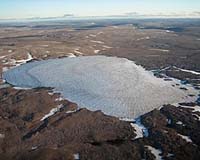 |
Leicester, UK (SPX) Aug 13, 2010 An international team of scientists including Mark Williams and Jan Zalasiewicz of the Geology Department of the University of Leicester, and led by Dr. Thijs Vandenbroucke, formerly of Leicester and now at the University of Lille 1 (France), has reconstructed the Earth's climate belts of the late Ordovician Period, between 460 and 445 million years ago. The findings have been published online in the Proceedings of the National Academy of Sciences of the USA - and show that these ancient climate belts were surprisingly like those of the present. The researchers state: "The world of the ancient past had been thought by scientists to differ from ours in many respects, including having carbon dioxide levels much higher - over twenty times as high - than those of the present. However, it is very hard to deduce carbon dioxide levels with any accuracy from such ancient rocks, and it was known that there was a paradox, for the late Ordovician was known to include a brief, intense glaciation - something difficult to envisage in a world with high levels of greenhouse gases. " The team of scientists looked at the global distribution of common, but mysterious fossils called chitinozoans - probably the egg-cases of extinct planktonic animals - before and during this Ordovician glaciation. They found a pattern that revealed the position of ancient climate belts, including such features as the polar front, which separates cold polar waters from more temperate ones at lower latitudes. The position of these climate belts changed as the Earth entered the Ordovician glaciation - but in a pattern very similar to that which happened in oceans much more recently, as they adjusted to the glacial and interglacial phases of our current (and ongoing) Ice Age. This 'modern-looking' pattern suggests that those ancient carbon dioxide levels could not have been as high as previously thought, but were more modest, at about five times current levels (they would have had to be somewhat higher than today's, because the sun in those far-off times shone less brightly). "These ancient, but modern-looking oceans emphasise the stability of Earth's atmosphere and climate through deep time - and show the current man-made rise in greenhouse gas levels to be an even more striking phenomenon than was thought," the researchers conclude.
Share This Article With Planet Earth
Related Links University of Leicester Explore The Early Earth at TerraDaily.com
 Primitive rocks may hold early Earth clues
Primitive rocks may hold early Earth cluesWashington (UPI) Aug 11, 2010 Geologists say rocks collected from Baffin Island in the Canadian arctic suggest the area can offer clues to the early chemical evolution of Earth. Researchers from the Carnegie Institution say beneath the island lies a region of Earth's mantle that has escaped the billions of years of melting and reforming that has affected the rest of the planet, an institution release said Wednesday. ... read more |
|
| The content herein, unless otherwise known to be public domain, are Copyright 1995-2010 - SpaceDaily. AFP and UPI Wire Stories are copyright Agence France-Presse and United Press International. ESA Portal Reports are copyright European Space Agency. All NASA sourced material is public domain. Additional copyrights may apply in whole or part to other bona fide parties. Advertising does not imply endorsement,agreement or approval of any opinions, statements or information provided by SpaceDaily on any Web page published or hosted by SpaceDaily. Privacy Statement |